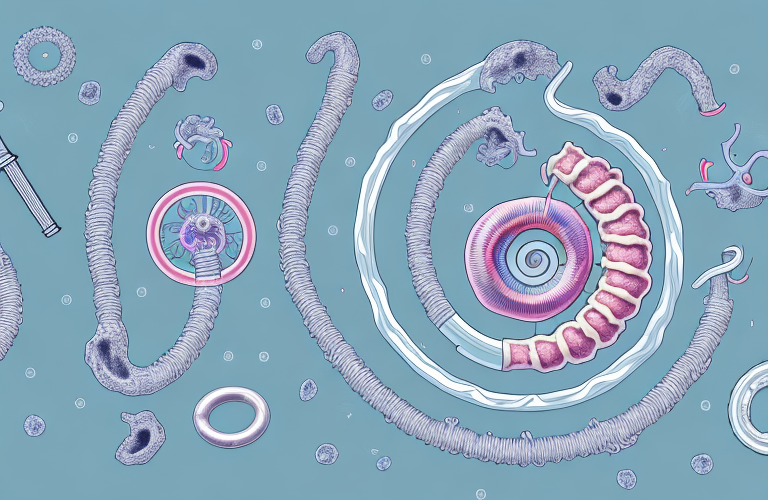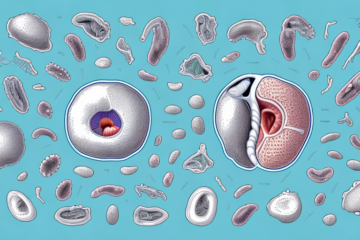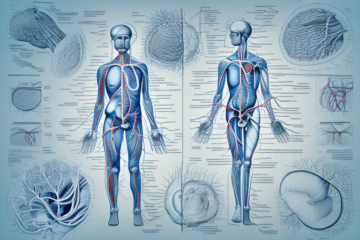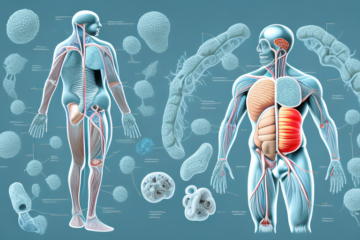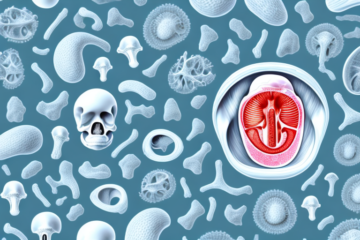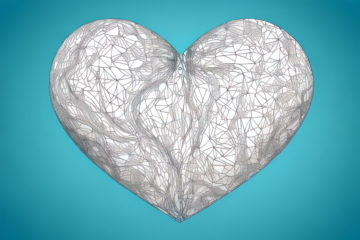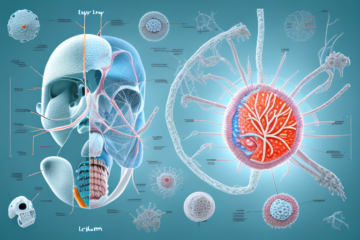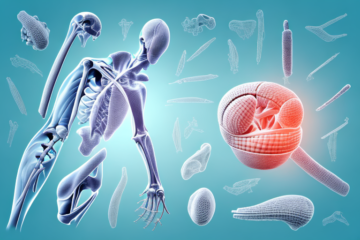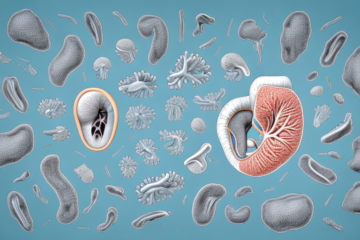The trachea is a crucial part of our respiratory system, responsible for carrying air from the nose and mouth all the way to the lungs. In this article, we’ll take a closer look at the anatomy of the trachea, its functions, and common disorders that can affect it. We’ll also outline treatment options and preventive measures you can take to keep your trachea healthy.
An Overview of the Trachea and Its Functions
The trachea, also known as the windpipe, is a tube-like structure that connects the larynx or voice box to the bronchi of the lungs. Its primary function is to allow air to pass from the nose and mouth to the lungs and vice versa. The trachea is made up of cartilage rings, which provide structural support to maintain the tube’s shape and prevent it from collapsing during breathing.
In addition to its primary function, the trachea also plays a crucial role in protecting the lungs from harmful substances. The trachea is lined with tiny hair-like structures called cilia, which help to trap and remove particles such as dust, pollen, and bacteria from the air before it reaches the lungs. This process is known as mucociliary clearance and is essential for maintaining healthy respiratory function.
Understanding the Anatomy of the Trachea
The trachea is approximately 4-5 inches long and about an inch in diameter in adults. It starts from the bottom of the larynx and extends towards the chest. The trachea divides into two main bronchial tubes inside the lungs, which then divide into smaller branches called bronchioles that lead to the air sacs.
The lining of the trachea is covered by cilia and mucus-secreting cells that trap foreign particles, such as dust and bacteria, and prevent them from entering the lungs. The cilia work together to move the mucus and trapped particles up the trachea and out through the mouth or nose.
The trachea is also known as the windpipe and is a vital part of the respiratory system. It is made up of cartilage rings that provide support and prevent the trachea from collapsing. The trachea is also surrounded by muscles that help to regulate airflow during breathing. In addition, the trachea is innervated by the vagus nerve, which controls the muscles involved in breathing and helps to regulate the rate and depth of breathing.
The Role of the Trachea in Respiratory System
The trachea is an essential part of the respiratory system. As air enters the trachea, it is warmed, moistened, and filtered by the nasal passages and then reaches the trachea, where it is further filtered by the mucus and cilia. Oxygen is then exchanged for carbon dioxide in the small air sacs inside the lungs, allowing the body to retrieve oxygen necessary for cellular respiration and to exhale waste gases.
In addition to its role in respiration, the trachea also plays a crucial role in protecting the airways from foreign objects. The trachea is lined with a layer of mucus that traps dust, bacteria, and other particles that may enter the airways. The cilia, which are tiny hair-like structures on the surface of the trachea, then move the mucus and trapped particles up and out of the airways, preventing them from entering the lungs. This protective mechanism helps to prevent infections and other respiratory problems.
How Does the Trachea Work?
The trachea works by contracting and expanding during inhalation and exhalation, respectively. During inhalation, the muscles surrounding the trachea relax, allowing it to expand and let air enter the lungs. During exhalation, the muscles contract, and the trachea narrows to push out waste gases.
The trachea is also lined with tiny hair-like structures called cilia, which help to filter out any foreign particles or debris that may have entered the airways. These cilia move in a coordinated motion, sweeping mucus and trapped particles up and out of the trachea and into the throat, where they can be coughed up or swallowed. This process helps to keep the lungs clean and free of harmful substances.
The Importance of the Trachea in Breathing
The trachea is critical to breathing, and any damage or blockage can cause significant breathing difficulties and even respiratory failure. For example, if a foreign object, such as food or a small toy, gets lodged in the trachea, it can cause difficulty breathing or choking. Similarly, if the trachea is damaged, it can lead to inflammation, bronchitis, pneumonia, or other lung infections.
It is important to keep the trachea healthy and functioning properly. One way to do this is by avoiding smoking and exposure to secondhand smoke, as this can cause damage to the trachea and increase the risk of respiratory problems. Additionally, practicing good hygiene, such as washing your hands regularly and covering your mouth when coughing or sneezing, can help prevent the spread of infections that can affect the trachea and lungs. Regular exercise and maintaining a healthy diet can also improve lung function and reduce the risk of respiratory issues.
Common Disorders and Diseases Affecting the Trachea
Several disorders can affect the trachea, including tracheitis, tracheal stenosis, tracheomalacia, and tracheobronchomalacia, among others. These conditions can cause inflammation, scarring, narrowing, or weakening of the trachea, leading to breathing difficulties, coughing, wheezing, or other respiratory symptoms.
Tracheal tumors are another condition that can affect the trachea. These tumors can be benign or malignant and can cause similar symptoms as other tracheal disorders. Treatment options for tracheal tumors may include surgery, radiation therapy, or chemotherapy, depending on the type and stage of the tumor.
Symptoms and Diagnosis of Tracheal Disorders
The symptoms of tracheal disorders depend on the underlying condition. However, common symptoms include difficulty breathing, noisy breathing, coughing, wheezing, chest pain, fever, and fatigue. To diagnose a tracheal disorder, doctors may perform various tests, such as chest X-rays, CT scans, bronchoscopy, or spirometry.
In addition to these tests, doctors may also take a medical history and perform a physical exam to help diagnose a tracheal disorder. They may ask about any previous respiratory illnesses or surgeries, as well as any medications or environmental factors that could be contributing to the symptoms. During the physical exam, doctors may listen to the patient’s breathing and check for any abnormalities in the trachea or surrounding tissues.
Treatment Options for Tracheal Conditions
The treatment for tracheal conditions depends on the underlying cause and severity of the symptoms. Treatment options may include medications, such as bronchodilators, inhaled corticosteroids, and antibiotics, among others. In severe cases, surgery may be necessary, such as tracheal reconstruction, stenting, or removal of the damaged part of the trachea.
In addition to medical and surgical treatments, lifestyle changes can also help manage tracheal conditions. Quitting smoking and avoiding exposure to irritants, such as pollution and chemicals, can reduce inflammation and improve breathing. Regular exercise and a healthy diet can also strengthen the respiratory system and improve overall health.
It is important to work closely with a healthcare provider to develop a personalized treatment plan for tracheal conditions. This may involve regular monitoring of symptoms, adjusting medications as needed, and following up with imaging tests to assess the effectiveness of treatment. With proper care and management, many people with tracheal conditions can lead healthy and active lives.
Surgical Procedures for Tracheal Reconstruction or Repair
Surgical procedures for tracheal reconstruction or repair may include a variety of techniques, such as resection and anastomosis, tracheal dilation, and tracheal stenting, among others. These procedures aim to restore the trachea’s normal function by removing or repairing the damaged tissue or widening the airway.
One of the most common causes of tracheal damage is trauma, which can result from a variety of accidents, such as car crashes or falls. In some cases, tracheal damage may also be caused by medical conditions, such as tumors or infections. The severity of the damage will determine the type of surgical procedure that is required.
Tracheal reconstruction or repair is a complex procedure that requires a skilled surgeon and a team of medical professionals. Patients who undergo these procedures may require a lengthy recovery period and may need to undergo additional treatments, such as physical therapy or speech therapy, to fully regain their normal function. However, with proper care and treatment, many patients are able to fully recover and resume their normal activities.
Preventive Measures and Lifestyle Changes to Keep Your Trachea Healthy
While some tracheal disorders cannot be prevented, many lifestyle changes can help you keep your trachea healthy. These may include quitting smoking, avoiding exposure to air pollution and respiratory irritants, staying hydrated, exercising regularly, and maintaining a healthy diet. Additionally, taking precautions to prevent infections, such as washing hands frequently and avoiding close contact with sick people, can help reduce your risk of developing tracheal disorders.
In conclusion, the trachea plays a vital role in our respiratory system and is susceptible to various disorders and diseases that can significantly affect our breathing. If you experience any symptoms of tracheal disorders, such as difficulty breathing, coughing, or chest pain, seek medical attention right away. By taking preventive measures and maintaining a healthy lifestyle, you can keep your trachea healthy and functioning correctly.
It is also important to note that certain occupations and hobbies may put individuals at a higher risk for tracheal disorders. For example, individuals who work in construction or manufacturing may be exposed to respiratory irritants and pollutants, while those who participate in activities such as woodworking or metalworking may inhale fine particles that can damage the trachea. If you work in a high-risk occupation or have a hobby that may expose you to respiratory irritants, it is important to take extra precautions to protect your trachea, such as wearing a mask or respirator.

